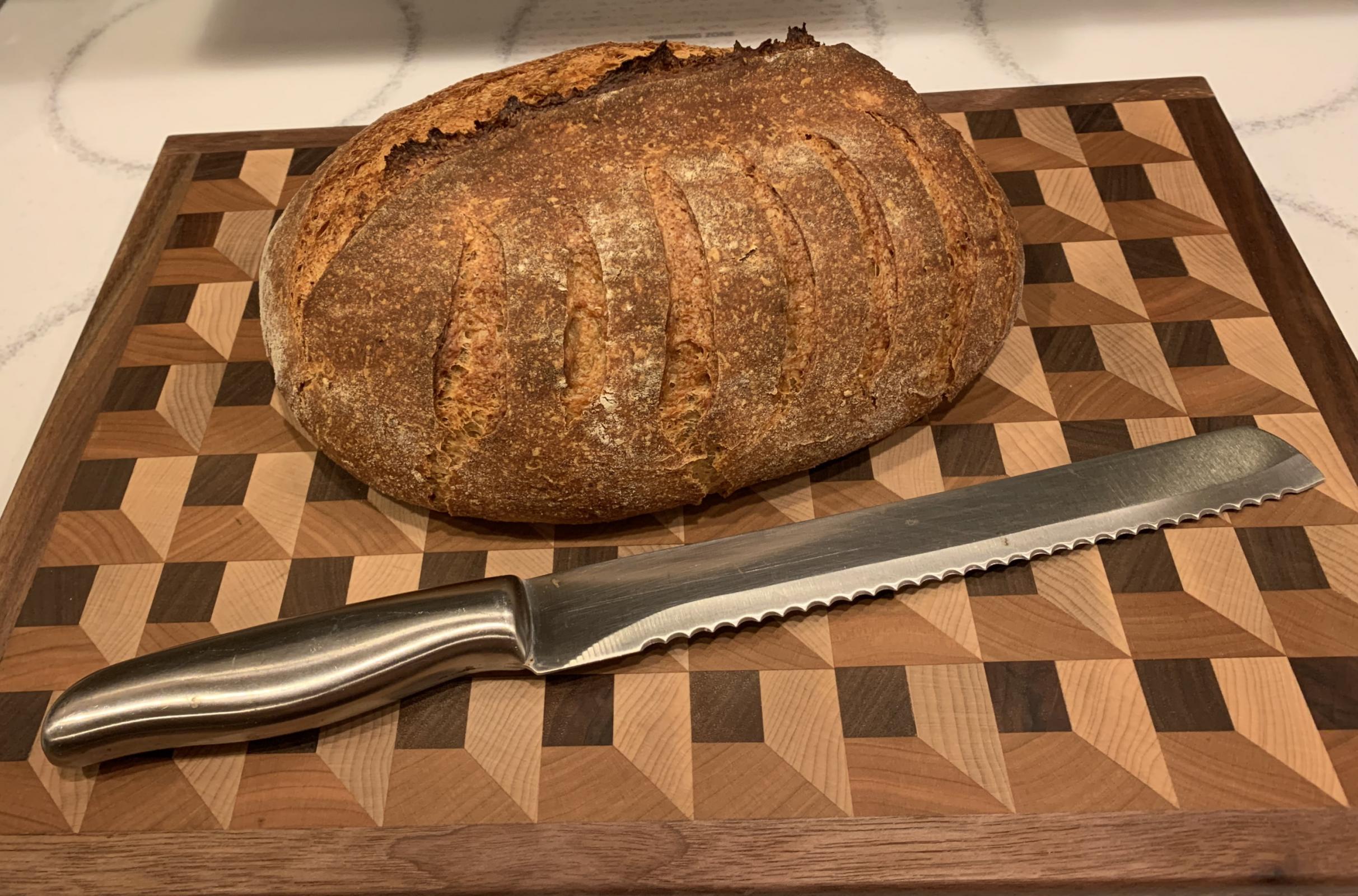No secret I love barley flour in my bakes. It's just a flavor I enjoy. This bake is based on a recipe in The Finnish Cookbook by Beatrice Ojakangas. I converted from volume to weight as best I could and took a few liberties.
1) I replace half the rye flour with rye chops
2) I added a YW pre-ferment that incorporated all the rye flour and half of the barley flour
3) I used the rye chops, half the barley flour, and crushed fennel seed in a whole milk scald
4) Eliminated the butter
At this point, I'm not sure I can call it Hiivaleipa anymore, which means "yeast bread" according to the author. Her recipe is a straight dough formula.
I used the old honey based YW for one last bake while my new raisin YW is brewing. I used a 2-stage build this time, and whether it was from the YW, the 2-stage build, or the flour mix (I'm leaning here and the YW), this was the first time in the little over a year that I have been baking SD that I experienced a strong acetic acid levain. The first aroma when I opened the levain jar was vinegar. Plain as day. Once I started stirring, the aroma shifted to more of a sour apple.
The dough was fairly sticky but stiff after the initial mix. I used bassinage to add water during the first set of kneading. I lost count, but guessing I added roughly 5-7% water during bassinage. I added water until I had a sticky but supple dough. It did lose some of the stickiness during the bowl kneading process and then a little more during bulk, but I had to use a little more than normal flour during pre-shaping and shaping because of the stickiness.
Final product is a bread with a crispy crusty and seems reasonably airy by initial feel. It is on the heavy side, so I think it retained a fair amount of moisture. Hopefully not gummy. The fennel seed aroma is not overpowering and I definitely get the barley/sour rye aromas as well (which is interesting since I started with a YW but we've kicked that one around enough in the forums).
Makes one loaf...
Total Dough
90g All Purpose Flour (20%) - King Arthur
180g Bread Flour (40%) - King Arthur
45g Rye Chops (10%)
45g Dark Rye Flour (10%) - Bob's Red Mill
90g Barley Flour (20%) - Food to Live
162g Yeast Water (36%)
203g Whole Milk (45%)
8.1g Salt (1.8%)
4.5g ADY (1%)
1/2 tsp Crushed Fennel Seeds
1st Stage Pre-Ferment (10% PFF)
22.5g Dark Rye Flour
22.5g Barley Flour
54g Yeast Water
2nd Stage Pre-Ferment (20% PFF)
22.5g Dark Rye Flour
22.5g Barley Flour
45g Bread Flour
108g Yeast Water
All of 1st Pre-Ferment
Whole Milk Scald
45g Rye Chops
45g Barley Flour
1/2 tsp Crushed Fennel Seed
202.5g Whole Milk
Final Dough
90g All Purpose Flour
135g Bread Flour
8.1g Salt
4.5g ADY
Day/Night Before
1) Combine all ingredients for 1st Stage Pre-Ferment and ferment at 76 deg F for 7 hours
2) Pre-heat towel covered Crock Pot to 150 deg F. Weigh out scald flours and fennel seed and set aside. Pre-heat whole milk in a covered bowl in the microwave to 165-170 deg F. Dump scald flours in whole milk and stir to wet all flours. Immediately cover tightly with foil and place in Crock Pot overnight.
3) Combine all ingredients for 2nd Stage Pre-Ferment and ferment at 76 deg F for 12 hours
Day of Bake
1) Increase Crock Pot temperature to 185 deg F. Hold there until scald temp reaches at least 180 deg F.
2) Combine Final Dough ingredients including salt and yeast. Mix them very well using whisk to evenly distribute ADY and salt.
3) Add scald and levain to dry ingredients and mix. Use hands to mix and insure all the flour is wetted. Adjust hydration with water if needed.
4) 15 minute rest
5) Bowl kneading for 24-30 folds. Keep folding until you start to see the start of gluten formation and dough development. Bassinage during this step (if needed) until you have a supple dough. 10 minute rest
6) Bowl kneading 15-20 folds. Dough should start to take shape and firm up a bit. 10 minute rest
7) Bowl kneading 12-15 folds. Stop when dough starts to show signs of smoothing and firming up.
8) Place dough in oiled bowl and ferment at 76 deg F until doubled in size (75 minutes for me)
9) Pre-shape into a boule
10) 15-20 minute rest
11) Final shape round or oval
12) Pre-heat oven to 410 deg F; bake at 410 deg F (20 minutes with steam); vent oven; bake at 400 deg F (10 minutes), lower to 375 deg F (15 minutes)
13) Due to high hydration and scald, take internal temp high to drive off excess moisture. I took internal temp to 209+ deg F
Scoring for this dough inspired by Isand66 and his recent bake. Seemed to work well. Got a nice ear and decent expansion. A little more spread than loft, but probably to be expected with 40% whole grain that has minimal gluten content. Crumb pictures tomorrow after giving it ~18 hours to cure.

